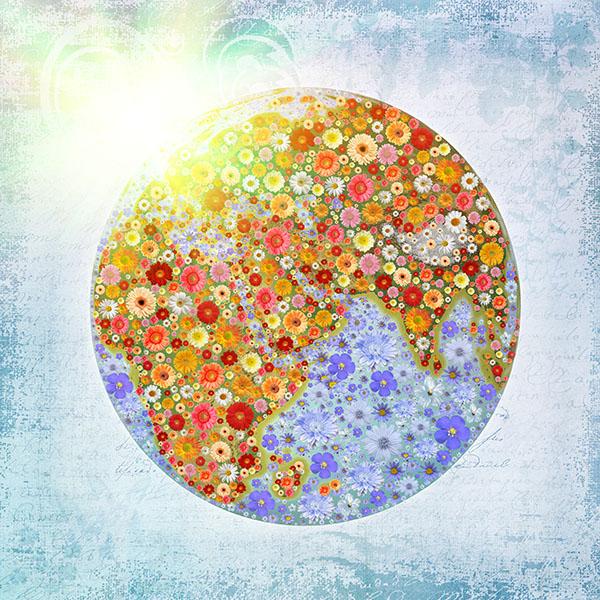
Flower Essences in Times of Stress and Fear
by Richard Katz
This article was written in March, 2020, as the COVID-19 pandemic began spreading around the world.
Flower essences were born in an earlier time of crisis
Flower essences were first developed during an earlier time of traumatic economic and social upheaval, the Great Depression of the 1930s. In the face of today’s challenges, these potent plant remedies can be important allies as we seek the wisdom, inner strength, emotional equanimity and resolve needed to meet a new world crisis.
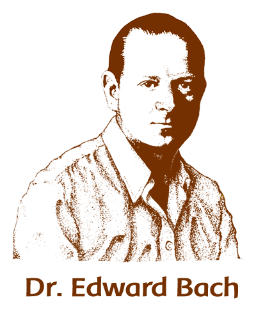 Flower essences originated with Dr. Edward Bach (1886-1936), an English physician whose work spanned the first third of the twentieth century. Trained at the University Hospital in London as a bacteriologist, Bach began his career at the start of World War One, treating war casualties and victims of the great influenza epidemic of 1918. It was a time of profound world crisis, when the nineteenth century’s optimistic assumptions of unending human progress were shattered, as millions died in the trenches and hospital beds. During that time Bach himself nearly died of illness, but he came through the experience with a renewed sense of life purpose — to find the source of disease and a truly natural and effective way of treating it.
Flower essences originated with Dr. Edward Bach (1886-1936), an English physician whose work spanned the first third of the twentieth century. Trained at the University Hospital in London as a bacteriologist, Bach began his career at the start of World War One, treating war casualties and victims of the great influenza epidemic of 1918. It was a time of profound world crisis, when the nineteenth century’s optimistic assumptions of unending human progress were shattered, as millions died in the trenches and hospital beds. During that time Bach himself nearly died of illness, but he came through the experience with a renewed sense of life purpose — to find the source of disease and a truly natural and effective way of treating it.
The effects of stress and fear on health

Bach saw first-hand the effects of “shell shock,” what we now call Post-Traumatic Stress Disorder. He realized the profound influence of emotional and stress reactions on physical health. He also realized that emotional health is not separate from spirituality, and that issues of moral values, life purpose and destiny are as important, if not more so, than diet, exercise and pathogens in determining human health. Long before the advent of psychosomatic and holistic medicine, Bach was a pioneer in recognizing the crucial spirit-mind-body connection in disease and health.
Although we have no evidence that Bach spoke directly of the social and economic turmoil of his age, it is clear from his remedies that he was offering medicine for a time of fear and despair, themes which represent more than half of his 38 remedies. Knowing how the flu pandemic of 1918 swept through the world with such frightening devastation early in Bach’s medical career, it is clear that he was speaking from experience when he wrote the following in his 1931 treatise, Heal Thyself,
“In this age the fear of disease has developed until it has become a great power for harm, because it opens the door to those things we dread and makes it easier for their admission.”
Fear of disease leads to more disease
Bach goes on to explain that “While lower forms of life, such as bacteria, may play a part in or be associated with physical disease, they constitute by no means the whole truth of the problem, as can be demonstrated scientifically or by everyday occurrences. There is a factor which science is unable to explain on physical grounds, and that is why some people become affected by disease while others escape, although both classes may be open to the same possibility of infection. Materialism forgets that there is a factor above the physical plane which in the ordinary course of life protects or renders susceptible any particular individual with regard to disease, of whatever nature it may be. Fear, by its depressing effect on our mentality, thus causing disharmony in our physical and magnetic bodies, paves the way for invasion…”
 Is it the “germ” or the “terrain” that causes disease?
Is it the “germ” or the “terrain” that causes disease?
Bach was making an important point here in our understanding of the nature of disease, with its one-sided emphasis on “germs” or pathogens (microbes such as bacteria and viruses). This discussion echoes the nineteenth century dispute between Louis Pasteur (1822-1895), who argued that germs (pathogens) cause disease in otherwise healthy individuals, and his contemporaries Antoine Béchamp (1816-1908) and Claude Bernard (1813-1878) who contended that disease pathogens are opportunistic and thrive in an unhealthy organism, where they find suitable “terrain” or milieu interieur (interior environment).
Organic gardeners know that it is the health of the soil (the terrain) that determines the health of the plants and their susceptibility to disease and pests. Similarly, maintaining a healthy inner “terrain” is the key to human health.
Science shows how stress and fear affect the body and the immune system
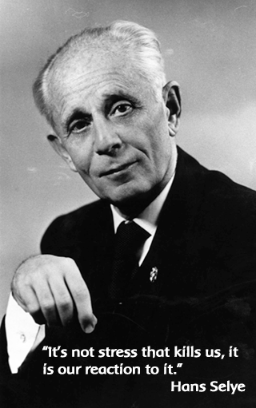 Further research by Walter Cannon (1871-1945) (The Wisdom of the Body) and Hans Selye (1907-1982) (The Stress of Life) established that emotions and stress reactions had direct effects on the autonomic nervous system and endocrine glands. Cannon developed the term “flight or fight” to describe the way the adrenal glands and the sympathetic nervous system are aroused in a response to extreme stressors. Hans Selye, who brought the term “stress” into common language, showed how a constant state of alarm reaction to chronic psychological stress was a precursor to many diseases.
Further research by Walter Cannon (1871-1945) (The Wisdom of the Body) and Hans Selye (1907-1982) (The Stress of Life) established that emotions and stress reactions had direct effects on the autonomic nervous system and endocrine glands. Cannon developed the term “flight or fight” to describe the way the adrenal glands and the sympathetic nervous system are aroused in a response to extreme stressors. Hans Selye, who brought the term “stress” into common language, showed how a constant state of alarm reaction to chronic psychological stress was a precursor to many diseases.
I find it significant that Selye’s seminal work on stress was begun in the mid-1930s, the same time that Dr. Bach was completing his flower remedies for the emotional factors of health, and the world was convulsed by the rise of Fascism, Nazism and militarism with the ongoing world-wide stress of the Great Depression.
Psychoneuroimmunology maps the pathways for the effects of emotions on immune health
It was after the Second World War that the study of stress became more widely known, as the everyday stresses of modern life began to take their toll with an increase in chronic disease. In the 1980s a new medical specialty was developed called Psychoneuroimmunology (PNI), which is mapping the specific neurological and endocrine pathways by which emotional states such as chronic anxiety and stress reactions create immune-suppressing reactions.
For example, at the 2017 Congress of the Neuroscience Education Institute, a presentation by Mary D. Moller, PhD on the effects of chronic fear on health described the following:
- Immune system dysfunction
- Endocrine system dysfunction
- Autonomic nervous system alterations
- Sleep/wake cycle disruption
- Eating disorders
- Alterations in hypothalamus-pituitary-adrenal axis
-
If we lose our emotional balance in the face of illness and crisis, then we are undermining our ability to resist or recover from disease. One can speak of specific immune responses to pathogens through the development of antibodies. However, a larger understanding of immune health is the ability of an organism to maintain its integrity and restore equilibrium when confronted with stresses or opportunistic infections.
 Connection with spiritual purpose and psychological balance is key to immune health
Connection with spiritual purpose and psychological balance is key to immune health
Dr. Bach’s insights nearly a century ago are now accepted science. Our emotions have tangible effects on our health, but our contemporary approach to illness and health often neglects this key factor. However, Bach’s understanding of the mind-body connection went far beyond what materialistic medical science studies, the neurological and biochemical pathways from the brain to the endocrine and immune systems.
Bach’s pioneering contribution was to recognize the importance of the psyche, which is the Greek word for “soul,” and the root word of psychology (study of the soul). The brain is the receptor of the thoughts and feelings of our soul, which is the mediator between our spiritual being and our physical organism. The immune system is what distinguishes between what can be part of our organism and what is destructive to the integrity of our organism. On a psycho-spiritual level, this represents the integrity of our core identity.
This is a larger subject than can be explored fully here. What is important to understand in the context of immunity and disease is that our connection with our spiritual purpose and our psychological balance is key to optimizing our health and immune resiliency. Bach knew this truth early in his life, and this understanding is the foundation of flower essence therapy.
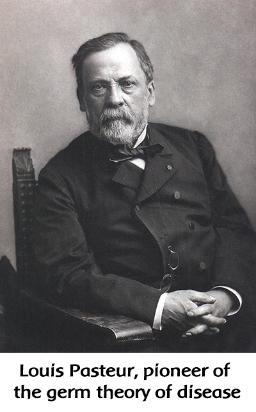 Disease is an interaction of the “germ” and the “terrain”
Disease is an interaction of the “germ” and the “terrain”
Common sense and our lived experience tell us that both Pasteur and Béchamp had valid points. This is not a binary choice between the “germ” and the “terrain.” Calling attention to the importance of our interior environment is not a denial of the reality of disease transmission by microbes. Humanity has made great strides in controlling communicable disease by improvements in hygiene, for example, to reduce disease transmission. However, the results of that transmission are determined by the “terrain” that we maintain, our “inner environment.” That’s why in this current pandemic, so much emphasis is placed on the vulnerability of people with immune-compromising conditions. Since disease organisms are found throughout our environment, cultivating our terrain, building immune health and strength, is something each of us can do to reduce the risk of disease.
There is no silver bullet
There is no silver bullet, nothing that will magically solve our problems, not a flower essence, herb, drug or pattern of behavior that will promise freedom from pain or disease. We need to work on many levels to maximize health and minimize our susceptibility to disease, both individually and as a society, especially to protect our most vulnerable among us as much as possible.
The COVID-19 pandemic is a stress-test for our society
The containment strategies of social distancing and quarantine that the world is now experiencing are designed to slow the spread of disease so as not to overtax our medical system. This is not a long-term strategy for health. Rather, it is an emergency measure to reduce the shock to already dysfunctional medical and socioeconomic structures, and mitigate the threat to vulnerable populations. The current pandemic is a stress-test for our society, and should be a wake-up call to address the long-term problems with a medical system that is more about managing illness than promoting health, and an economic system that rewards greed and neglects the common good, and which is destroying the ecosystem that sustains our lives.
The pandemic is a reminder and an opportunity to develop our best practices for healthy immunity on an individual and collective basis. We need to pay attention to healthy diet, sleep rhythms, exercise, social bonding, and especially our psychological and spiritual health. It is also an opportunity to see how we can create more bonds of compassion for those who are more vulnerable, to strengthen the social “safety net,” and develop more sustainable local economies and food sources that are less dependent on global sources. It is ironic that “social distancing” is a containment strategy, while at the same time we need social solidarity to realize we are all in this struggle together.
Fl ower essences can help
Flower essences are not “feel good” magic drops. Rather they help us connect with our inner sources of emotional and spiritual strength, so that we may meet the challenges that face us with fortitude, compassion and clarity. For many years, FES has had a donation program to help people dealing with natural and man-made disasters, so we know that flower essences can be a source of comfort and strength and help people deal with the disruption and subsequent recovery.
Crisis is an opportunity for service
Fundamentally, a crisis is an opportunity for service. When Bach wrote about fear of disease in Heal Thyself, he made this further point, “Such fear is really self-interest, for when we are earnestly absorbed in the welfare of others there is no time to be apprehensive of personal maladies.” Bach was fond of making categorical statements, and of course those who do service must take care of their own well-being so that they can continue to serve. However, there is a fundamental lesson here, that we can meet adversity by transforming fear for our own well-being into compassion for the suffering of others, converting the paralysis of anxiety into courage to act for the greater good.
The Prayer of Saint Francis
I can think of no greater embodiment of the ideal of fearless heart-felt compassion and selfless service than St. Francis of Assisi. I offer his prayer as a guiding light for this time of challenge:
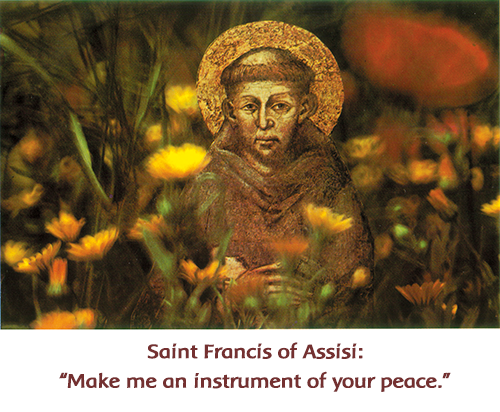 Make me an instrument of your peace,
Make me an instrument of your peace,
Where there is hatred, let me sow love;
Where there is injury, pardon;
Where there is doubt, faith;
Where there is despair, hope;
Where there is darkness, light;
Where there is sadness, joy.
May I not so much seek
To be consoled as to console;
To be understood as to understand;
To be loved as to love.
For, it is in giving that we receive;
It is in pardoning that we are pardoned;
It is in dying that we are born to eternal life.
In the spirit of spiritual courage, I offer this powerful verse based on a lecture by Rudolf Steiner. Although he was referencing the troubling times a century ago, these are words that can speak to each of us today no matter what spiritual path calls to us:
We must acquire serenity in all feelings and sensations about the future.
We must look forward with absolute equanimity to everything that may come.
And we must think only that whatever comes is given to us by a world-directive full of wisdom.
It is part of what we must learn in this age, namely, to live out of pure trust, without any security in existence.
Trust in the ever present help of the spiritual world.
Truly, nothing else will do if our courage is not to fail us.
And let us seek the awakening from within ourselves every morning and every evening.

To install this Web App in your iPhone/iPad press ![]() and then Add to Home Screen.
and then Add to Home Screen.

